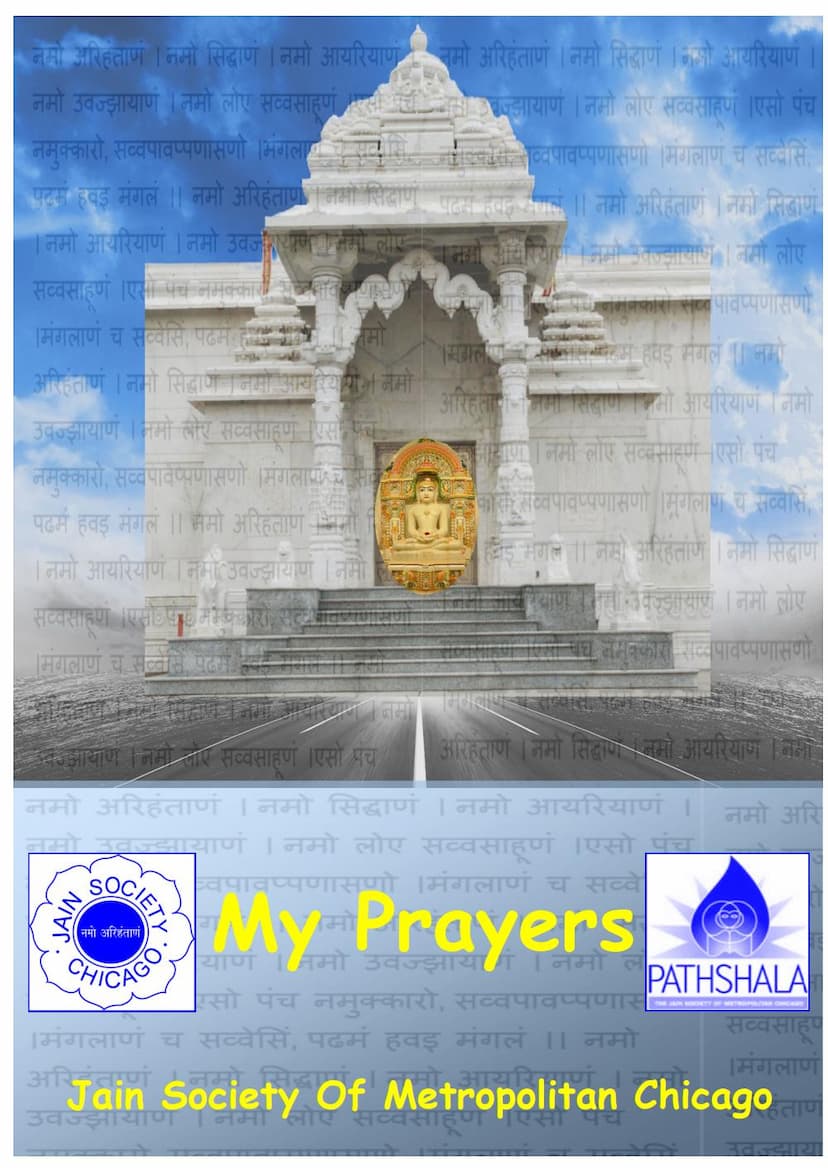My Prayers
Added to library: September 2, 2025

Summary
The book "My Prayers," published by the Jain Society of Metropolitan Chicago, is a comprehensive guide to Jain prayers, devotional songs, and rituals, designed for personal and educational use. The catalog link provided is https://jainqq.org/explore/009485/.
Core Content and Purpose:
The primary purpose of this book is to provide Jain community members, especially children and those learning about Jainism, with accessible and meaningful ways to connect with their faith through prayer and devotion. It aims to facilitate spiritual upliftment, control over passions, and purification of thoughts and actions by offering traditional prayers with their English transliterations and meanings.
Key Features:
- The Namaskara Mahamangal Sutra (Page 13-14): This is presented as the foundational prayer, the Panch Parmesthi Namaskara (Namo Arihantänam, Namo Siddhänam, Namo Äyariyänam, Namo Uvajjhäyänam, Namo Loe Savva-Sahunam). Its meaning as the destroyer of all sins and the most auspicious of all auspicious things is highlighted.
- Chattari Mangalam Sutra (Page 15): This sutra emphasizes the auspiciousness of the Arihantas, Siddhas, Sädhus/Sadhvis, and the Jain Dharma as explained by the omniscient ones. It also serves as a declaration of taking refuge in these entities.
- Various Prayers and Stutis (Page 17-38): The book includes a wide range of prayers (stutis) and devotional songs (bhakti geet) in Gujarati, Hindi, and English. These prayers often focus on:
- Praising the Tirthankaras (e.g., Rishabhadev, Parshvanath, Mahavir).
- Expressing devotion and seeking spiritual guidance.
- Reflecting on Jain principles like non-violence (Ahimsa), compassion, and equanimity.
- The significance of Darshan (seeing the idols of Tirthankaras).
- Árati and Ashta Prakäri Puja (Page 52-68): The book provides detailed instructions and mantras for performing the eightfold worship (Ashta Prakäri Puja) and Árati (worship with lamps), common devotional practices in Jainism.
- Chaitya Vandan (Page 60-96): A significant portion of the book is dedicated to Chaitya Vandan, a formal ritual of veneration of Tirthankar idols and sacred places. This section includes:
- Preparation Rituals: Procedures like Khama-samana Sutra for seeking forgiveness, and Iriyavahiyam Sutra for atoning for potential violence during movement.
- Käyotsarga: Instructions for meditation and renunciation of bodily activities.
- Logassa Sutra: A praise of all 24 Tirthankaras.
- Chaitya Vandan Stotras: Recitation of prayers dedicated to specific Tirthankaras and sacred sites.
- Namorhat Sutra: The Sanskrit version of the Namaskara Mantra.
- Uvasaggaharam Stotra: A powerful stotra dedicated to Bhagawan Parshvanath for protection and spiritual well-being.
- Jay Viyaraya Sutra: A prayer seeking detachment, right conduct, spiritual guidance, and ultimate liberation.
- Concluding Prayers: Recitation of auspicious verses and the Navakar Mantra to conclude the rituals.
- Educational Value: The inclusion of English transliterations and meanings makes the complex Prakrit and Sanskrit prayers accessible to a wider audience, facilitating a deeper understanding and personal connection with the teachings.
- Community Involvement: The book acknowledges the contributions of various individuals and sponsors, highlighting the community's effort in compiling and publishing this resource. The mention of the "Päthashälä teachers and students" as inspiration underscores its educational mission.
- Jain Principles: Throughout the text, core Jain principles like Ahimsa (non-violence), Anekantvad (multiplicity of views), and Aprigraha (non-attachment) are implicitly or explicitly reinforced through the prayers and their meanings.
In essence, "My Prayers" serves as a valuable resource for spiritual practice and education within the Jain tradition, offering a structured approach to prayer, worship, and the veneration of Tirthankaras and the Jain path to liberation.